Through the forest, and up we go.
Lush green forests and rivers running through a valley. Always on their way down, looking for the quickest and easiest way. Over those, you can see rail tracks, lazily winding up the valley towards their target location.
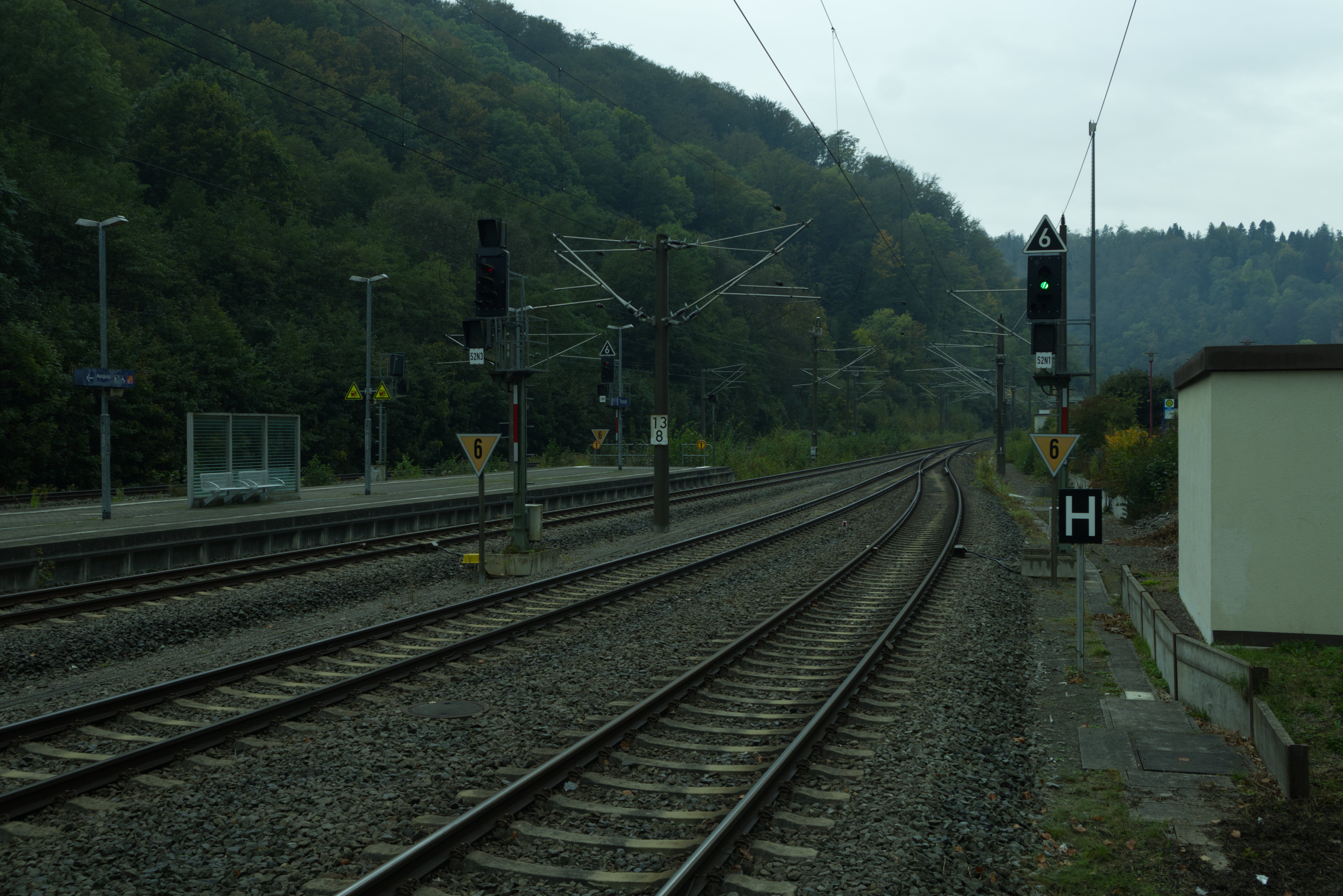
Over those, you can see rail tracks, lazily winding up the valley towards their target location. The “Tharandter Rampe” might not be the steepest hill train's had to tame in Germany, but it's one of many interesting structures the builders had to create for the rail connection between Tharandt and Freiberg at the time. If you're not into rail tracks at all, and you visit Dresden at one point, Give Tharandt and the “Tharandter Wald” a go. It's a great landscape with many places to visit and should be easy to reach over the train station of Tharandt itself. But today, I want to give a (really) small look at the three stations along the rail track here.
And a small one it will be.
I only decided to write this article while I was hiking along the rail tracks of the “Tharandter Rampe”. A hike I wanted to do for quite a while now and finally did a few days ago. I wasn't really prepared for getting enough pictures of everything to give you an in-depth look at the rail track and surrounding buildings. Based on that, let's make this a small introduction to this location and the train stations along the track. I will get back to this region at some point anyway, and then I might focus more on specific locations or dive deeper into the history behind it all.
So … what is the “Tharandter Rampe” exactly?
As mentioned earlier, the “Tharandter Rampe” was built as part of the rail route between Tharandt and Freiberg, but is nowadays part of the way longer route between Dresden and Werdau. As the “Tharandter Rampe” we specifically refer to the 11.6-kilometer-long rails lying between the stations Tharandt and Klingenberg-Colmnitz. The trains have to climb 228 meters in altitude in this section to get from Tharandt to Klingenberg-Colmnitz. With that, it's certainly not the biggest altitude difference trains have to climb in Germany alone. But the “Tharandter Rampe” is named as one of the bigger climbs on main routes in Germany that trains have to drive up or down without any additional gear.

The "Wilde Weißeritz" running into Tharandt alongside the rail tracks. Both are on their way in opposing directions.
In the early days of this section, a second engine had to help the trains get up and down the incline. Nowadays, the trains used by the “Mitteldeutsche Regionalbahn”, the “Coradia Continental” or short: electric trains, produced by Alstom, drive up and down this incline alone and without any difficulty. But of course, I am speaking as someone who isn't a train driver himself and certainly has no clue if this section is more challenging to them regarding applying acceleration and brake usage. The rail route itself and the train stations are nowadays maintained by the “Deutsche Bahn”, used by the “Mitteldeutsche Regionalbahn” to provide train service on the Rail Routes Dresden-Zwickau (RB30) and Dresden-Hof (RE3). It also seems like the S3, run directly by the “Deutsche Bahn”, gets to run the full track section a few times over the week.
The section is running along the edge of the Forest “Tharandter Wald”, side by side with the River “Wilde Weißeritz” between Tharandt and Edle Krone and with the River “Seerenbach” between Edle Krone and Klingenberg-Colmnitz. Even if you don't care about trains and the infrastructure surrounding them, the valley landscape, which the rail tracks are running through, is beautiful and interesting to explore. But try to avoid some hiking paths running alongside the roads. I found them not really nice to walk on, especially considering that you are basically walking on the same streets the traffic is driving on. Also, Be prepared to change your hiking route on the fly, because quite a few were blocked by trees or were broken off when I tried to walk on them. Off course, it's something you always have to deal with when hiking, but on the day of my tour, it certainly seemed like this valley seemed to be more prone to have this problem. It at least didn't look like these paths were neglected overall.

The Street K9071 from Edle Krone coming running parallel to the elevated rail tracks of the Dresden-Werdau route, the vast area of the Tharandt forest being to the right of both.
The Starting Point
I started my short hike in Tharandt, actually travelling by train down the “Tharandter Rampe” before starting my little hiking adventure. My target was to basically walk 'up' the “Tharandter Rampe”, which of course isn't exactly doable because I can't step onto the Rails and walk on them while the trains are still driving up and down the Rail Route. But I liked at least the theoretical Idea of walking as close as possible (and allowed) alongside the tracks, seeing them going up and enjoying the nature surrounding them.
All three stations, along the “Tharandter Rampe”, are not really using their reception buildings for the day-to-day service any more. Also, many of the additional buildings like engine sheds, warehouses, and residential buildings got removed, especially when they lost their usefulness when we moved into our more modern era. But from these three, Tharandt is actually the only station in this section who got a new reception building over time and completely lost its original one.
The original reception building of the Tharandt station was build in 1854 and was demolished in 1910, meaning it only got to an age of 56 years. I honestly like the look of the old reception building a bit more than the more Swiss-orientated 'new' one.

Black and white photo of the old reception building of the train station, Tharandt. Source of this Picture: Sachsenschiene.de
But I don't want to say, I found the new reception building an ugly building. Quite the opposite … ignoring the fact, that the plaster wasn't there when I visited the space. Apparently, I am not completely sure, the building is now in the hands of a private landlord or at least a company with the target to create flats in the reception building. The renovations apparently started last year around November, seeing it still in a state like that isn't really getting my hopes up for a finished building in the near future.
Overall, I am not really a fan of completely changing the inner structure of an historical building like that, but I have to be honest to myself: We can't turn everything into a Museum. Having an old building of a train station changing in its usage, but keeping it in its original design on the outside, is already enough for keeping the historical picture somewhat alive. Especially when there are many more historical buildings out there, which haven't got any treatment at all and are falling apart as you read these sentences.
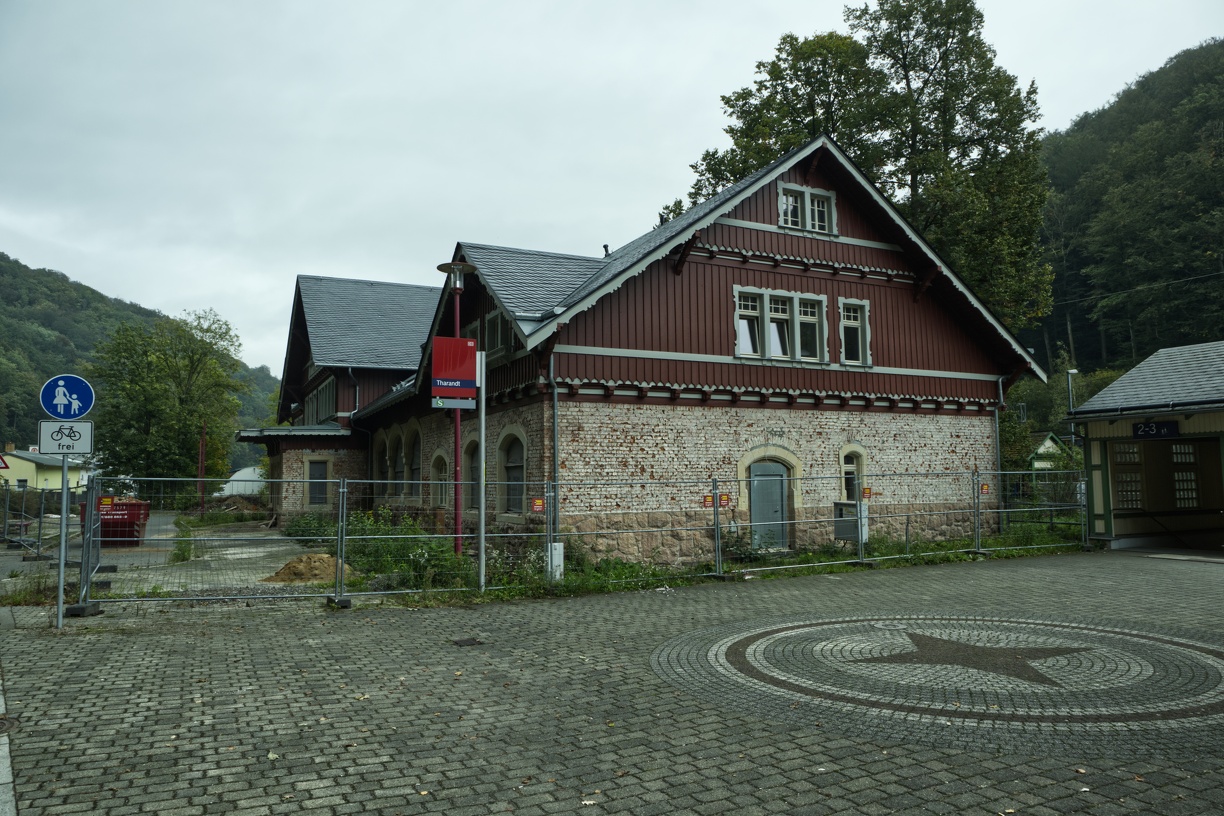
Picture of the Station Building of the Train Station "Tharandt" currently being renovated.
The newer reception building we can see nowadays was build from 1908 to 1909. It hasn't really changed over time, nice to see. For comparison to the days, when the building was fresh and new and as an orientation how it could look with finished plaster and everything, I found two photos on the great Website “Sachsenschiene.net”. A page concerned with gathering Information and pictures surrounding all rail routes we still have nowadays and rail routes we put out of service in saxony. If you are speaking German and you are interested in the history of Saxonian rail routes or at least rail routes or old buildings of train stations in general: Give it a go, I really like clicking through the page reading through everything and learning something about our rail-related history.
|
|
|
|
An old Postcard of the reception building of the Tharandt Station. The picture shows the building from the side of the platforms. |
A picture of the reception building from the street side. Even though it's pretty rough looking, you can at least see a bit more how it should look compared to the picture I took. |
Source of both Pictures: Sachsenschiene.net
Two years after Tharandt got its new reception building, it also got its island platform and a tunnel for guests to get to the new platform. The Island platform and the tunnel are mostly as they were, when they were opened for the public.
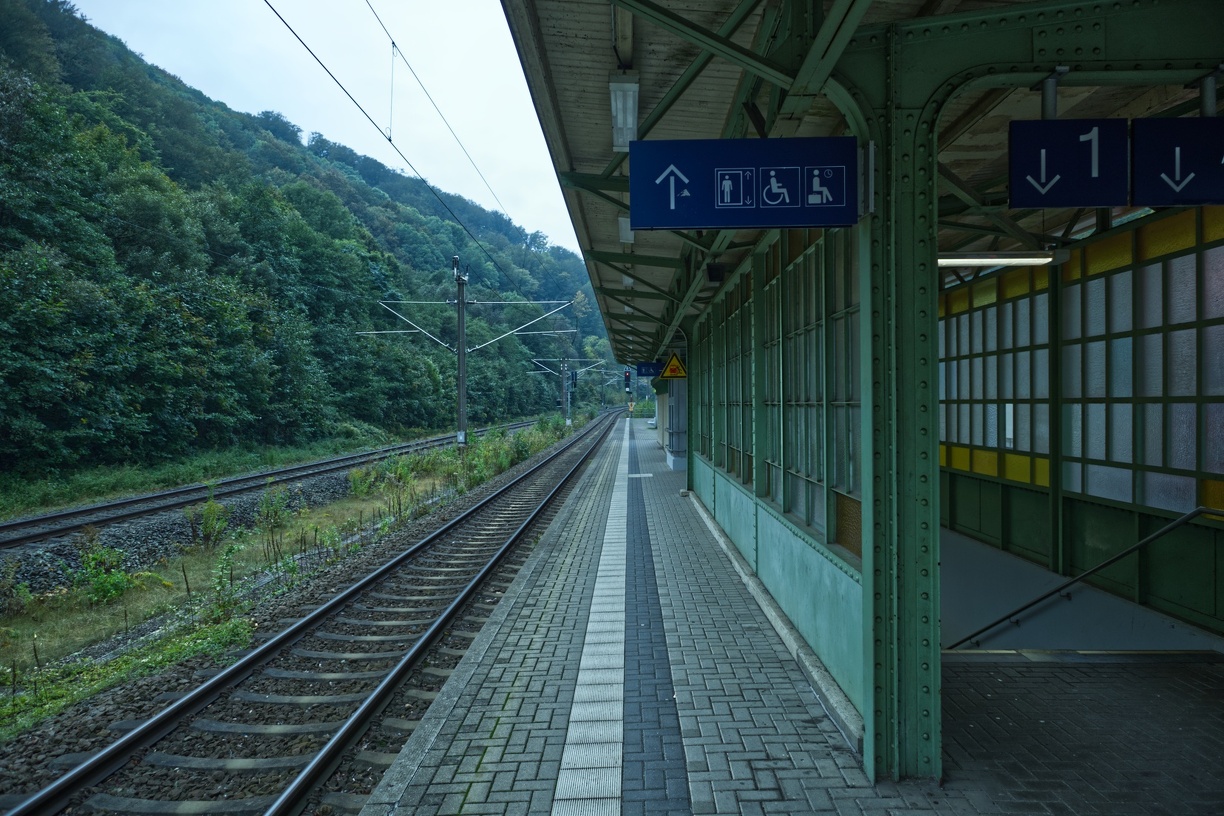
The Island platform, and its tunnel for passengers haven't really changed from when it was opened in 1911, besides, the newer signage the DB is placing on every station nowadays.

Picture from the Platforms of the Train Station "Tharandt". Visible are, besides the rail tracks, a red double-floor train of the DB, two platforms (one with a more modern-looking shelter and one with the old roof over it), and a bit of the old Station Building.
It's really nice to see the station being in a shape like that, even though a few small things here and there could look better. But I don't want to be too finical.
From the three station's, Tharandt is the one with the best connection's towards Dresden, Freiberg and the surrounding area. The, in 2004 created, transition point between the Trains and Buses, connects more or less four buses with the three rail lines running through the station. That may not sound much, but Tharandt isn't really that big and with our really mediocre public network in many places in saxony nowadays, Tharandt definitely is one of the better connected small towns here.
Only three years before the new transition point, in 2001, Tharandt got it's ESTW-A, which is a remote-controlled railway control centre controlled from Dresden-Altstadt. I don't know why and how I managed to ignore it when I was there, but I completely missed it. That means: No pictures from me of the outside of the ESTW-A of Tharandt and Klingenberg-Colmnitz. But if you are really curious: Both ESTW-A's are located close to the respective station, a bit into the direction Werdau (away from Dresden).
By the way, the route kilometre of Tharandt is 13.708. These kilometres are commonly measured from the starting point of the rail route, in this case “Dresden Hbf” (Dresden Main Station). In turn, that tells us, that Tharandt is 13.8 kilometres away from Dresden. For my German readers: Yes, I use the English way of writing numbers instead of our German ways. We are not suddenly thousands of kilometres away from Dresden.
The noble Crown
A bit more than four kilometres up the section, we arrive at the station “Edle Krone” which you can translate to “noble Crown”. But I keep it at “Edle Krone”, because that's what's standing on the signs of the station and the village located there. I like the article to be more consistent in these regards for people who might be interested in visiting these locations. The station “Edle Krone” is located at kilometre 18.02 of the rail route Dresden-Werdau.
Like in Tharandt, we find an Island platform and this time the original reception building. Starting with the Island platform, it got into service in 1907 and is still in its original design. Like in Tharandt, we also find the tunnel to the platform in the original state and well looked after.

Island platform of the stop "Edle Krone".
At the same time as the platforms got into service, the reception building was finished. In the official service, it nowadays gets mostly used for getting into the tunnel and to the platform. But on certain days, the doors might open to visit the exhibition of old railway stuff, collected by the association “Förderverein Edle Krone”. This association is also the current owner of the reception building and the group keeping this building in a good shape. When I was there, I really loved how well it was maintained and the beautiful location in the valley. Thanks to the association of rail enthusiasts, putting their own free time into keeping this building alive.
I only encountered a few problems, you might have to keep in mind. When visiting the place, I didn't really see opening times. But when hiking there, I didn't really know that there was an exhibit to explore anyway, so I didn't really look for them and of course found no opening times. I might have missed them, and the webpage of the association isn't displaying any opening times at all. Based on that, I guess the exhibition is only opened for big events. If there is something like that planned, I am sure the association is posting it on their webpage (www.edlekrone.de, the page is only available in German).
The second issue for people hiking: You can't really hike to the station easily. This doesn't mean that you can't. I walked to “Edle Krone” and away from it after all, but you have to walk along the road or honestly even on the road. Even though I had no difficulties with the cars and drivers I encountered, I wouldn't necessarily recommend walking on them when you can avoid it. There are nowadays many drivers out there, which I would not call “safe drivers”. Maybe travel by train to the station instead. Take a look around, and then jump onto the next train to Tharandt or Klingenberg-Colmnitz for further exploration in the forest or along the rail tracks.

The reception building of the stop "Edle Krone" looks as if it only opened yesterday, thanks to the "Edle Krone" association for keeping it in this great form.
Another reason why it could be interesting to visit “Edle Krone”, can be the tunnel and the bridge connecting to the station. Both are kind of in their original appearance, only the tunnel changed a bit when bridge and tunnel got expanded in between 1964 and 1965. But they don't look like they aged one day they since then. Paired with the location of the station on top of the really beautiful valley and a great overlook over the village, it's a really nice spot to check out.

Bridge over the Weißeritz Valley, leading directly into the "Edle Krone" station.
 |
 |
| Postcard of the original Tunnel. Source: Sachsenschiene.net | While the tunnel is still there, its appearance has changed a bit with the expansion of 1964/65. |
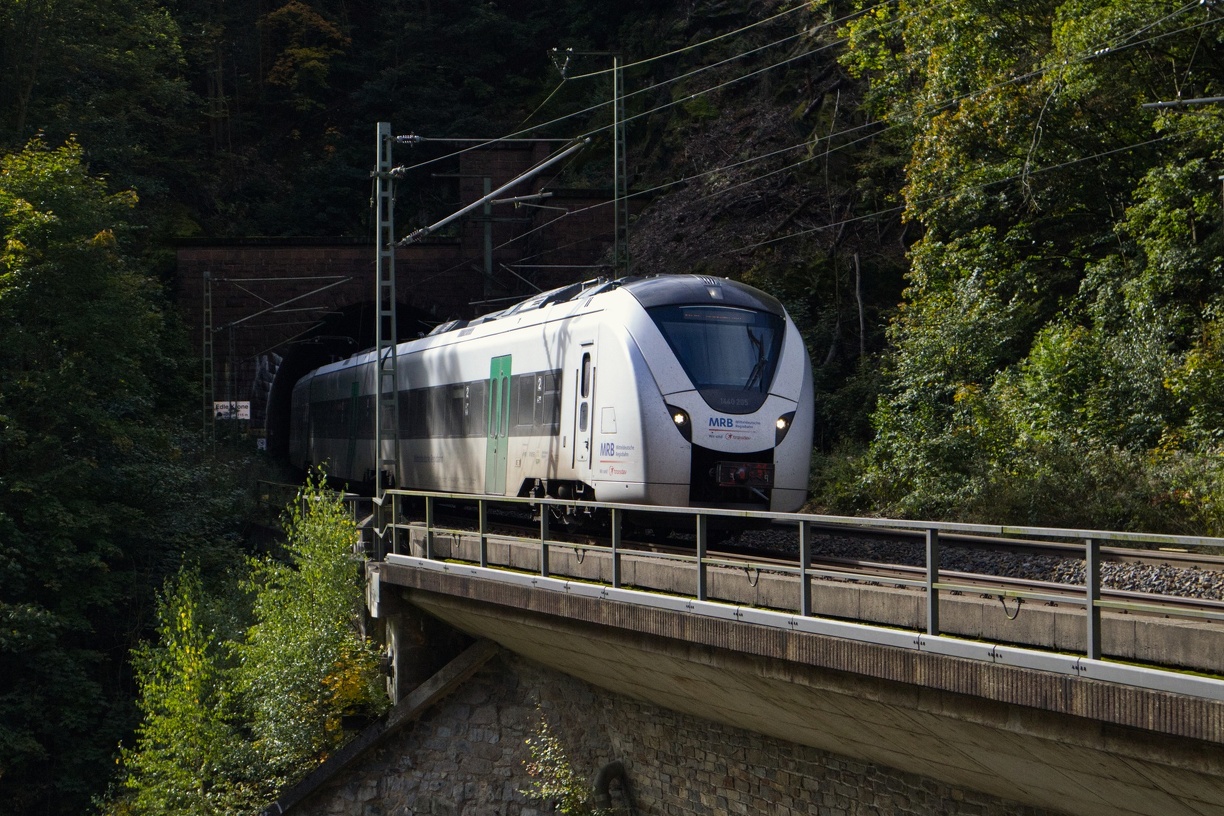
And obviously, the trains runing through have also changed completly.
The modern one
Originally it was kind of tempting to call the station “Klingenberg-Colmnitz”, located at kilometre 25.369 by the way, the ugly one. But that would not be fair at all, because the platforms are in a great shape. A 'great shape' definitely isn't something I would call the old reception building of Klingenberg-Colmnitz, which is with a year of construction in 1862 the oldest, still standing, one I saw on that day. I am not sure who the current owner of the building nowadays is, but especially compared to Tharandt and Edle Krone, it would be really great if the building either gets at least renovated or maybe even a second life.
By the way: If you are wondering, why there is a small piece of the wall newly plastered. That is the spot where the old tunnel to the Island platform was located. When the new tunnel was build and pushed into service, the old one got removed, including the buildings where you entered the tunnel on both sites (on the platform and besides the reception building). When they removed those buildings, they also had to newly plaster the reception building because the entrance of the tunnel was directly attached to it.
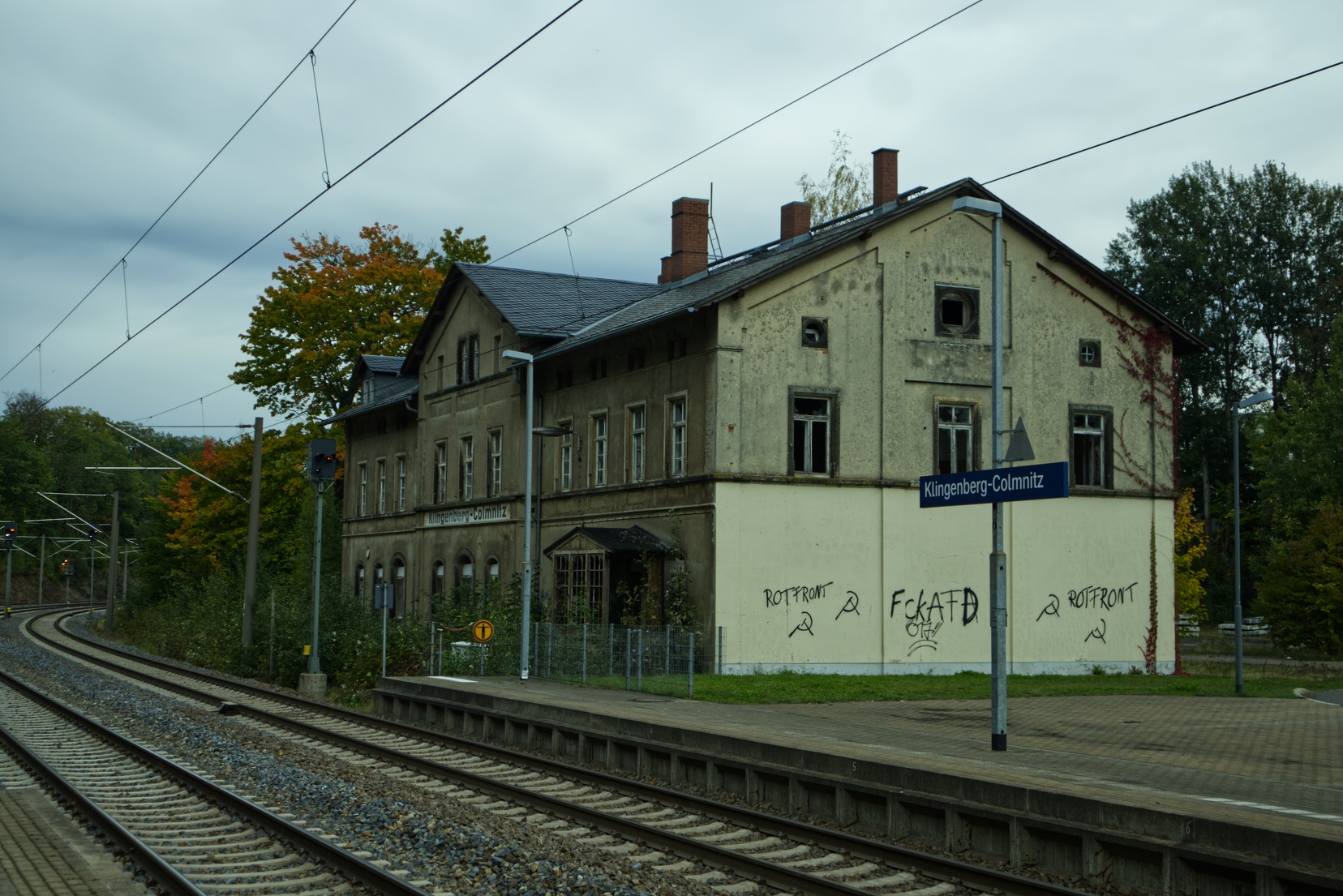
The reception building of the station Klingenberg-Colmnitz has definitely seen better days.

The reception building with the old tunnel towards the second platform, photographed in 2000. Source: Sachsenschiene.net

For Comparison: a Postcard picture from the good old days, when steam engines ruled the valley. Source: Sachsenschiene.net
Besides that, the platforms in use look fresh and modern. It got new lanterns, modern shelters, the new tunnel between the island platform and both sides of the station, which is nice because you can enter the station nowadays from every direction you want because of that. I didn't really found out, when the old entrance of the old tunnel got removed. But I guess it got either removed in 2003, when the new tunnel was build, or it got removed when the new bus station got build in 2009 directly attached to the second platform. By the way: This station has only a second and a third platform, there is no first platform.
 A view along the current platforms in the direction of Edle Krone and the old reception building of Klingenberg-Colmnitz.
A view along the current platforms in the direction of Edle Krone and the old reception building of Klingenberg-Colmnitz.
And with that, my short hike was at an end and this article will conclude as well. I really enjoyed my tour and I really enjoyed looking up old pictures, comparing them with the newer ones I took, but I really need to prepare myself better next time. I have a few other things I want to explore in the future, some train related, some without any connection to trains, and I think I want to do blog articles like that more often in the future. Then, of course, with a bit more preparation and maybe even looking a bit deeper into the history and changes the location's had to survive over time.
But for now, I thank you for reading and hope that even that small view into the past and current state of the “Tharandter Rampe” was interesting enough for you to read until the end. Maybe we see us again at one point in the future.
You can go up from every deep valley you find yourself in,
Your Wolkynir

